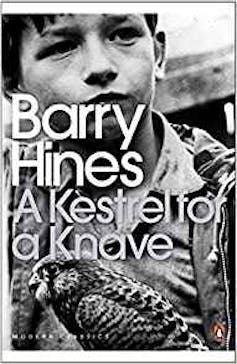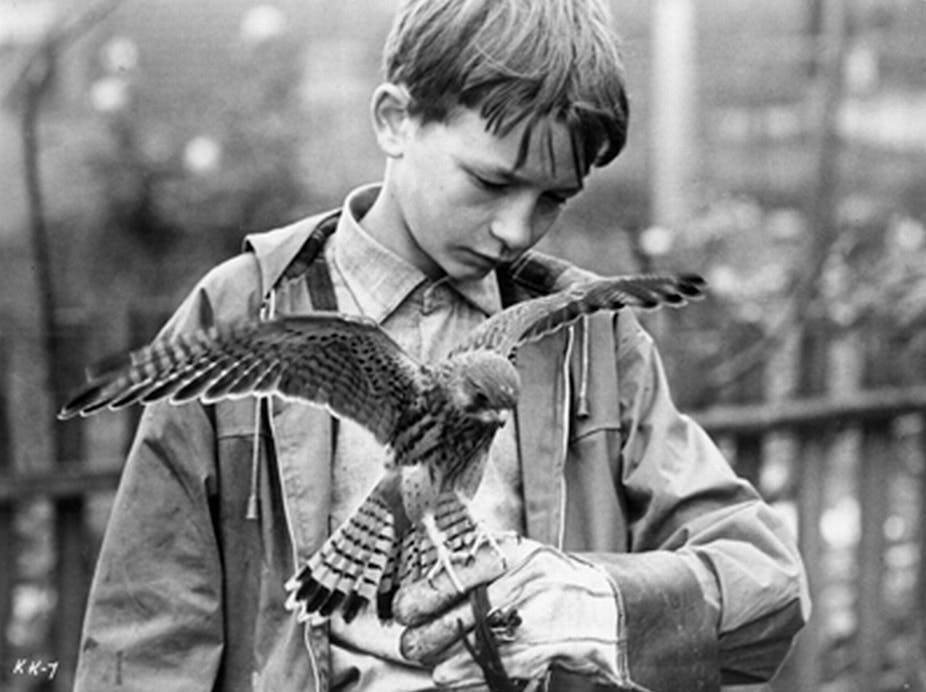Half a century ago, a working-class writer by the name of Barry Hines wrote a tale of an impoverished boy and the bird he befriends. It’s a simple story with complex themes, which struck a real chord with the Britain of 1968. Adapted into a classic film by Ken Loach the following year, A Kestrel for Knave is about the politics of education, about what, how, and why we learn. It also reminds us that the circumstances of our background determine our life chances – that class matters. Its themes are just as relevant five decades on.
For Hines, education was always political:
English literature was reading books about people who had been dead for hundreds of years … I wanted to read about a world I could identify, where people had to work for a living.
Hines, who was brought up in Barnsley, Yorkshire – in the same neighbourhood his most famous novel was situated – came to books relatively late in his own education. A keen schoolboy sportsman, he trained as a PE teacher at Loughborough College. But when a roommate lent him a copy of Orwell’s Animal Farm, Hines – then aged 21 – found himself, for the first time in his life, reading for pleasure. He was hooked.
Just four years later, while working at a school back home in Barnsley, Hines wrote his first radio play, Billy’s Last Stand, broadcast on the BBC in 1965. In 1966 his first book was published: The Blinder, a semi-autobiographical tale of a footballer caught between the worlds of football and academia.
This was an era when there was an appetite for working-class, regional writing. It was an era when writers from humble backgrounds had access to networks, so scarce today, that could open the doors of opportunity. Stan Barstow, the author of A Kind of Loving helped Hines secure a literary agent, and Alfred Bradley, the producer who had commissioned his first play, helped the young teacher access a BBC bursary for northern writers. Crucially, this subsidy gave Hines temporary leave from his job to focus on his next project.

It was during this period that Hines met Tony Garnett, another class warrior making popular political art. Fresh from producing Cathy Come Home with Loach, Garnett was looking for new writers. Would Hines write a TV play? “Not yet”, came the answer: “I’ve got this book going round in my head, and I’ve got to write it.”
Hines promised to tell Garnett and Loach when it was finished. They duly read the book – and the rest is history. In that moment the arts seemed open and accessible in a way that is unimaginable today – working-class voices were at the vanguard of cultural production.
It’s fair to say that the success of the film – and its iconic presence in the national imagination – has turned attention away from the novel on which it was based. But much of what gives the film its sense of lyricism emerged directly from Hines’s prose. Garnett described how the visual nature of Hines’s writing meant that the screenplay was “more or less a cut-and-paste job”. In early scripts, the producer and director literally copied pages from the book to punctuate the scenes of dialogue. These long passages of prose, highly textured descriptions of the South Yorkshire countryside, are written into the very fabric of the film.
Hines writes the landscape in minute, visceral detail – and in the process re-imagines the English pastoral tradition from a working-class perspective. The representation of nature becomes a political act.
Hard times
Hines’ lyricism offers readers a fleeting sense of relief from the harshness of Billy’s home and school life; where his imagination is allowed to prosper in defiance of those who oppress him. His brother, Jud, beats him, his mother neglects him, his classmates relentlessly mock him and, and in a scene made famous by the late Brian Glover, he is utterly and painfully humiliated on the football field.
It is against this backdrop of abuse that Billy meets Kes. His relationship with the kestrel unlocks a hunger for learning and, in the most arresting scene in the novel and film, Billy, so often silent and disinterested in school, is invited by his teacher to talk about his new-found passion for falconry. Billy finds a voice – and Mr Farthing and Billy’s classmates hang on his every word.
The liberation is tragically fleeting. Soon after Kes is killed by Jud.
Hines later remarked that if there had been “GCSEs for Falconry, Billy Casper would have been awarded an A grade”. But no such qualification exists – and by the end of the novel Billy is on the scrapheap, a victim of a class system which uses education to discipline rather than liberate its subjects.
In that moment when Billy is asked by his teacher to speak about Kes, our hero – up to this point utterly disengaged at school – finds agency for the first time, and Hines shows us a model of education where learning is an end itself. The classroom becomes a space of possibility, not of prescription. In these Utopian moments, the novel gives us hope.
I first read A Kestrel for a Knave at my own school, itself not far from Barnsley. I knew Billy Caspers, Juds, and Mr Sugdens. The story rang true, and Hines showed my classmates and me that working-class lives and landscapes were worthy of art. A Kestrel for a Knave has now disappeared from GCSE syllabuses, and there is little space for the novel elsewhere in a narrowing curriculum.
Five decades ago, the son of a miner wrote a book full of empathy and respect for someone who would today be sneered at by many as a “chav”. A Kestrel for a Knave was published across the world and Penguin enshrined it as a “Modern Classic”. This was literature of and for the people.
In 2018, the landscape is depressingly different. The economic decline of literary fiction must be understood as a class issue. Without radical thinking on access to the arts and creative industries, the Billy Caspers of post-industrial Britain will remain voiceless.

